Books
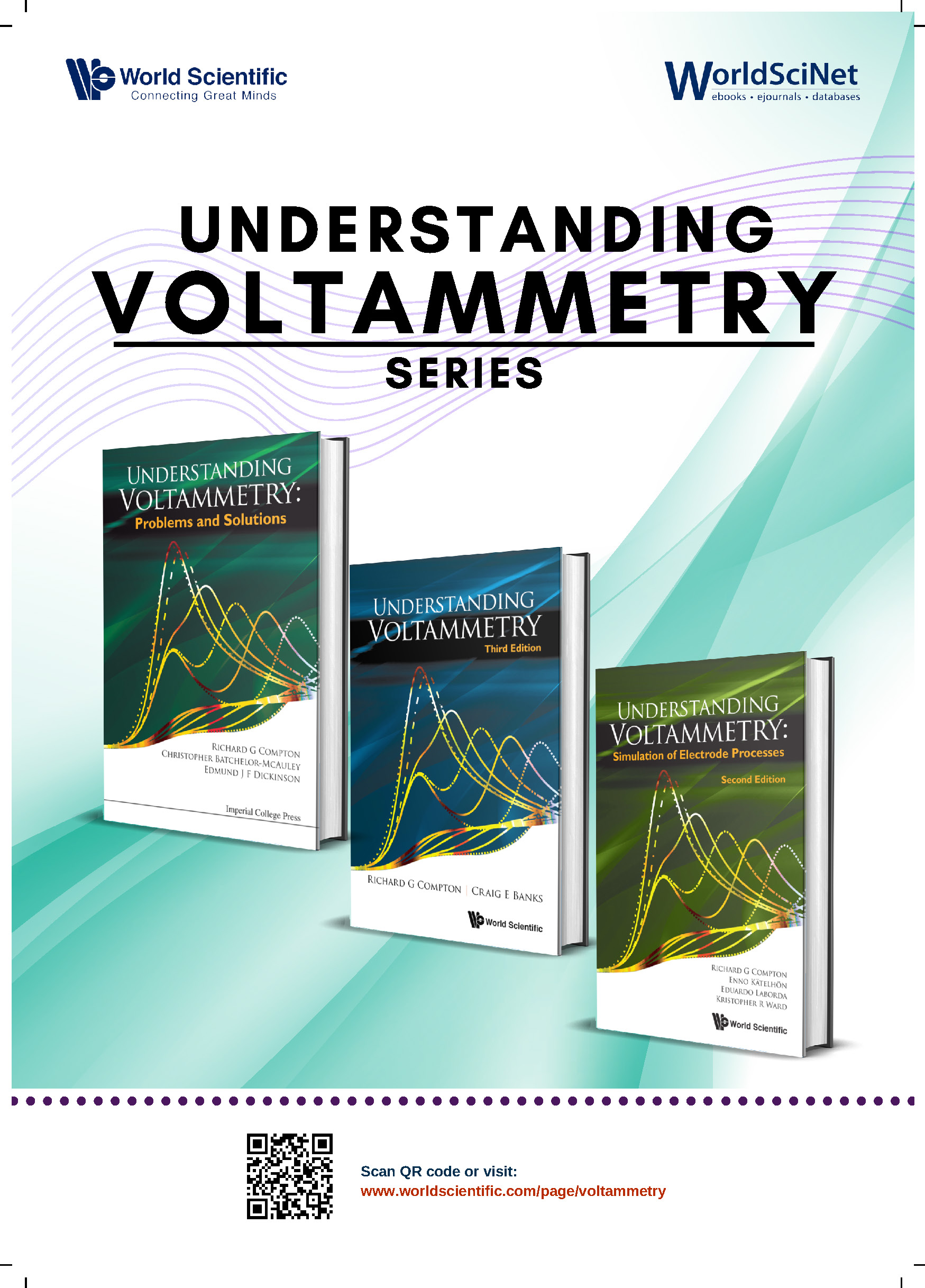
Latest Flyer from World Scientific
Richard G. Compton
World Scientific (2020)
https://www.worldscientific.com/page/voltammetry
Link (PDF flyer):
http://compton.chem.ox.ac.uk/news/images/Flyer Voltammetry.pdf
.
.
.
.
.
.
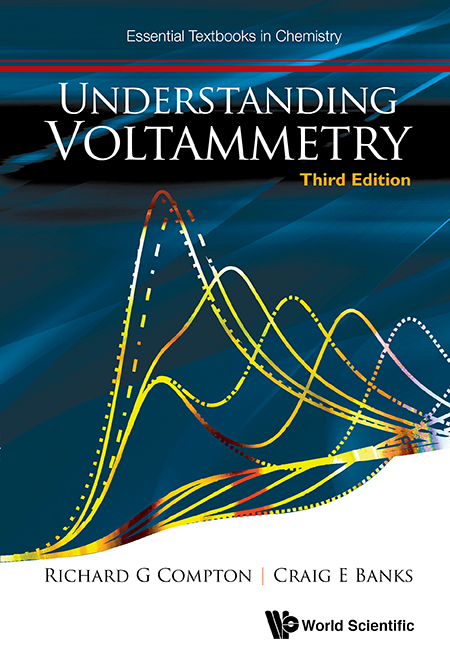
Understanding Voltammetry 3rd Edition
Richard G. Compton
Craig E. Banks
This textbook considers how to implement designing, explaining and interpreting experiments centered on various forms of voltammetry (cyclic, microelectrode, hydrodynamic, etc.). The reader is assumed to have knowledge of physical chemistry equivalent to Master's level but no exposure to electrochemistry in general, or voltammetry in particular. While the book is designed to stand alone, references to important research papers are given to provide an introductory entry into the literature.
The third edition contains new material relating to electron transfer theory, experimental requirements, scanning electrochemical microscopy, adsorption, electroanalysis and nanoelectrochemistry.
Sample chapter: 1. Equilibrium Electrochemistry and the Nernst Equation
https://www.worldscientific.com/doi/pdf/10.1142/9781786345271_0001
World Scientific (2018)
https://www.worldscientific.com/worldscibooks/10.1142/q0155
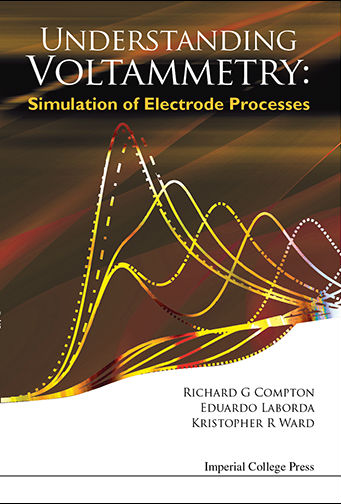
Understanding Voltammetry - Simulation of Electrode Processes
Richard G. Compton
Eduardo Laborda
Kristopher R. Ward
This is the first textbook in the field of electrochemistry that will teach experimental eletrochemists how to carry out simulation of electrode processes. Processes at both macro- and micro- electrodes are examined and the simulation of both diffusion-only and diffusion-convection processes are addressed. The simulation of prcesses with coupled homogeneous kinetics and at microelectrode arrays are further discussed.
Over the course of the book the reader's understanding is developed to the point where they will be able to undertake and solve research-level problems. The book leads the author through from a basic understanding of the principles underlying electrochemical simulation to the development of computer programs which describe the complex processes foudn in voltammetry.
This is the third book in the "Understanding Voltammetry" series, published with Imperial College Press and written by the Compton group. Other books in the series include "Understanding Voltammetry" (2010), written by Richard G. Compton and Craig Banks and also "Understanding Voltammetry: Problems and Solutions" (2012), written by Richard G. Compton with Christopher Batchelor-McAuley and Edmund Dickinson. These are and continue to be successful textbooks for graduates in electrochmistry and electroanalytical studies.
World Scientific (2014)
http://www.worldscientific.com/worldscibooks/10.1142/p910

Electrochemistry - Volume 11: Nanosystems Electrochemistry
Richard G. Compton
Jay D. Wadhawan
Relaunched in 2012 with a new editorial team (Compton and Wadhawan), the Specialist Periodical Report in Electrochemistry presents comprehensive and critical reviews in all aspects of the field. Specialist Periodical Reports present comprehensive and critical reviews of the current literature, with contributions from across the globe. The eleventh volume of Electrochemistry has a special focus on Nanosystems. Uniquely, this series will include a review of Chinese literature - opening up this expanse of information to the rest of the word. Topics examined in this volume include: Nanopore systems, metal organic frameworks, nanoparticles, nanocarbon electrochemistry, bipolar electrochemistry in nanosscience and electrochemistry with liquid nanosystems. This volume is a key reference in the field of electrochemistry, allowing the reader to easily become aquainted with the lastest research and opinion.
RSC Publishing (2013)
http://pubs.rsc.org/en/Content/eBook/978-1-84973-401-1#!divbookcontent
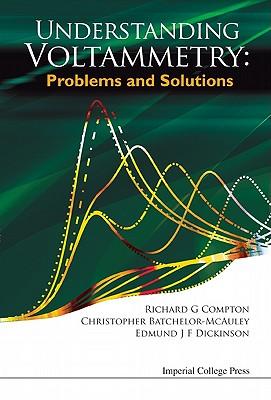
Understanding Voltammetry - Problems and Solutions
Richard G. Compton
Chris Batchelor-McAuley
Edmund J. F. Dickinson
The field of electrochemical measurement, with respect to thermodynamics, kinetics and analysis, is widely recognised but the subject can be unpredictable to the novice, even if they have a strong physical and chemical background, especially if they wish to pursue quantitative measurements. Accordingly, some significant experiments are, perhaps wisely, never attempted, while the literature is sadly replete with flawed attempts at rigorous voltammetry.
This book presents problems and worked solutions for a wide range of theoretical and experimental subjects in the field of voltammetry. The reader is assumed to have knowledge up to a Master's level of physical chemistry, but no exposure to electrochemistry in general, or voltammetry in particular, is required. The problems included range in difficulty from senior undergraduate to research level, and develop important practical approaches in voltammetry.
The problems presented in the earlier chapters focus on the fundamental theories of thermodynamics, electron transfer and diffusion. Voltammetric experiments and their analysis are then considered, including extensive problems on both macroelectrode and microelectrode voltammetry. Convection, hydrodynamic electrodes, homogeneous kinetics, adsorption and electroanalytical applications are discussed in the later chapters, as well as problems on two rapidly developing fields of voltammetry: weakly supported media and nanoscale electrodes.
There is huge interest in the experimental procedure of voltammetry at present, and yet no dedicated question and answer book with exclusive voltammetric focus exists, in spite of the inherent challenges of the subject. This book aims to fill that niche.
World Scientific (2012)
http://www.worldscibooks.com/chemistry/p783.html

A G Stromberg - First Class Scientist, Second Class Citizen
Richard G. Compton
Alexander S. Kabakaev
Michael T. Stawpert
Gregory G. Wildgoose
Elza G. Zakharova
Armin G Stromberg was arguably one of the founding fathers of the technique of stripping voltammetry frequently used in chemical analysis, yet he is virtually unheard of in Western scientific circles. He was a brilliant scientist, but due to his German ancestry he was interred in one of the NKVD GULAG camps at the outbreak of the Second World War.
This semi-biographical history presents the complete set of 74 surviving letters written by Stromberg to his wife during this period. The letters provide both historians and the interested public with a rare and unique glimpse into the everyday living conditions of inmates in one of the GULAG labour camps. The book also traces Stromberg's life following his release. More importantly, it relates how he founded the thriving Tomsk school to the wider historical context of electroanalysis in the USSR, drawing conclusions about the rate of scientific development as compared to the West and showing how 'wet analysis' remained of vital importance to industry long after equivalent measurements were made elsewhere.
Readers will also appreciate how Stromberg's invaluable contributions in the Tomsk School of Electroanalysis laid the foundations for the extensive metallurgical extraction and nuclear industries that dominated the entire Siberian region for many years. This book is a must-read for anyone interested in the life and times of an important, yet often overlooked scientist of the Second World War.
Imperial College Press (2011)
http://www.icpress.co.uk/histsci/p766.html
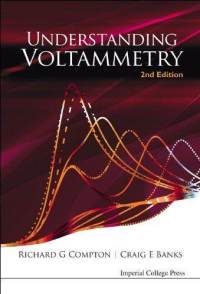
Understanding Voltammetry 2nd Edition
Richard G. Compton
Craig E. Banks
The power of electrochemical measurements in respect of thermodynamics, kinetics and analysis is widely recognized but the subject can be unpredictable to the novice even if they have a strong physical and chemical background, especially if they wish to pursue quantitative measurements. Accordingly, some significant experiments are perhaps wisely never attempted while the literature is sadly replete with flawed attempts at rigorous voltammetry.
This textbook considers how to go about designing, explaining and interpreting experiments centered around various forms of voltammetry (cyclic, microelectrode, hydrodynamic, and so on). The reader is assumed to have a knowledge to Masters level of physical chemistry but no exposure to electrochemistry in general, or voltammetry in particular. While the book is designed to 'stand alone', references to important research papers are given to provide an entry into the literature.
The book gives clear introductions to the theories of electron transfer and of diffusion in its early chapters. These are developed to interpret voltammetric experiments at macro-electrodes before considering microelectrode behavior. A subsequent chapter introduces convection and describes hydrodynamic electrodes. Later chapters describe the voltammetric measurement of homogeneous kinetics, the study of adsorption on electrodes and the use of voltammetry for electroanalysis.
In comparison to the first edition, two new chapters - transport via migration and nanoelectrochemistry - are added. Minor changes and updates are also made throughout the testbook to facilitate enhanced understanding and greater clarity of explanation
Imperial College Press (2011)
http://www.icpress.co.uk/chemistry/p726.html

Foundations of Physical Chemistry
Charles Lawrence
Alison Rodger
Richard Compton
This Oxford Chemistry Primer seeks to provide a foundation in physical chemistry suitable for students starting university courses in chemistry and allied subjects. It aims to link some material familiar from school (Advanced Level) studies with a selection of essential ideas usually encountered early in the freshman year. The first two chapters consider the structure of atoms and molecules. Chapters 3, 4 and 5 discuss chemical reactivity through energetics, kinetics and equilibria. Chapter 6 gives a brief insight into a few more advanced areas. It is hoped that the book will be accessible and stimulating to those studying Advanced Level chemistry whilst providing a sound basis for university work. The mathematical aspects of the subject have been minimised as far as is consistent with clarity.
A Japanese translation has been published by Kagaku-Dojin, and a Spanish edition has recebtly been published by Eudeba.
Oxford University Press (1996)
http://www.amazon.co.uk/Foundations-Physical-Chemistry-Oxford-Primers/dp/0198559046/

Electrode Potentials
Richard G. Compton
Giles H.W. Sanders
This Primer seeks to provide an introduction to the science of equilibrium electrochemistry; specifically, it addresses the topic of electrode potentials and their applications. It builds on a knowledge of elementary thermodynamics giving the reader an appreciation of the origin of electrode potentials and shows how these are used to deduce a wealth of chemically important information and data such as equilibrium constants; the free energy, enthalpy and entropy changes of chemical reactions; activity coefficients; and the electroactive sensing of ions. The emphasis throughout is on understanding the foundations of the subject and how it may be used to study problems of chemical interest. The Primer is directed towards students in the early years of their university courses in chemistry and allied subjects; accordingly the mathematical aspects of the subject have been minimised as far as is consistent with clarity.
Oxford University Press (1996)
http://www.amazon.co.uk/Electrode-Potentials-Oxford-Chemistry-Primers/dp/0198556845

Foundations of Physical Chemistry: Worked Examples
Nathan Lawrence
Jay Wadhawan
Richard Compton
The transition between school and university presents new challenges and ideas for the student of chemistry. This primer, written jointly by two undergraduates and a university professor is ideally suited to the needs of students at the school/university interface by taking material familiar from school and linking it with a selection of ideas that will be encountered in the freshman year. As well as stimulating pre-university students it will provide a sound basis for university courses in chemistry and related subjects. The early chapters cover the structure of atoms, ions and molecules, reactivity, kinetics, and equilibrium. The final chapter gives an insight into more advanced areas, drawing on real world examples.
Oxford University Press (1999)
http://www.amazon.co.uk/Foundations-Physical-Chemistry-Examples-Primers/dp/0198504624/


